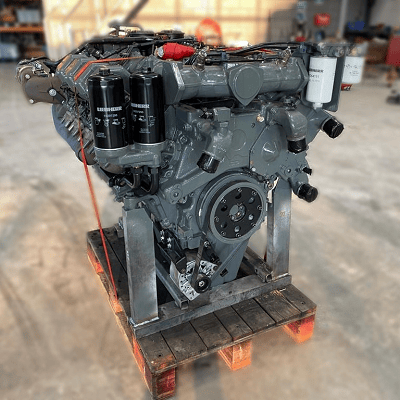The process of a dyno test on a Liebherr engine

When it comes to heavy machinery, reliability and power are paramount. Liebherr, a name synonymous with innovation and excellence in engineering, stands tall as a pioneer in the realm of heavy equipment and machinery. From towering cranes to robust excavators, Liebherr’s engineering prowess extends to the heart of these machines. We delve into the world of dyno testing a Liebherr engine, uncovering the meticulous process behind unleashing the raw power concealed within.
The foundation of excellence
Before we embark on the journey of dyno testing, it’s crucial to understand the foundation upon which Liebherr engines are built. With decades of engineering expertise and commitment to quality, Liebherr engines are crafted to withstand the most demanding environment and deliver unparalleled performance. Each component is meticulously designed and rigorously tested to ensure reliability, efficiency and longevity.
The process
1 Preparation: The engine undergoes meticulous preparation before being mounted onto the dynamo meter. This includes ensuring all connections are secure, fluids are filled to the appropriate levels, and sensors are properly calibrated.
2 Mounting: The engine is carefully mounted onto the dynamometer, a specialized device designed to simulate real-world operating conditions. Precision is paramount during this step to ensure accurate results.
3 Initial checks: Once mounted, a series of initial checks are conducted to verify proper alignment, connection integrity, and functionality of all engine systems.
4 Warm-up: The engine is started and allowed to warm up to operating temperature. This ensures consistent results and minimizes the risk of damage during testing.
5 Baseline testing: With the engine warmed up , baseline tests are conducted to establish initial performance metrics. This includes measuring power output, torque, fuel consumption, and emissions at various RPM levels.
6 Load testing: The engine is subjected to progressively increasing loads to simulate different operating conditions, such as idle, partial load and full load. This allows engineers to assess performance across the entire operating range and identify any potential issues or optimization.
7 Data analysis: Throughout the testing process, data is continuously collected and analyzed in real-time. Advanced instrumentation and software are used to monitor performance metrics and identify trends or anomalies.
8 Optimazation: Based on the data analysis, adjustments may be made to optimize engine performance. This could involve fine-tuning fuel injection timing, adjusting air-fuel ratios, or optimize turbocharger boost pressure.
9 Validation: Once testing is complete, the results are meticulously reviewed and validated against predetermined criteria and specifications. Any deviations or anomalies are thoroughly investigated to ensure accuracy and reliability.
10 Reporting: Finally, a comprehensive report is generated detailing the results of the dyno testing, including performance metrics, observations, and any recommendations for further optimization or refinement.
The outcome of dyno testing
Dyno testing a Liebherr engine is more than just a routine procedure – it’s a testament to the unwavering commitment to excellence that defines Liebherr’s engineering philosophy. By subjecting their engines to rigorous testing and analysis, Liebherr ensures that each engine delivers the uncompromising performance, reliability, and efficiency that customers expect.
In conclusion, dyno testing a Liebherr engine is not just about measuring power output. It’s about unlocking the true potential of these remarkable engines and ensuring they exceed expectations in the most challenging environments imaginable.
A Wood Fired Pizza Oven is a timeless piece of culinary equipment, revered for its ability to produce pizzas with unparalleled flavor and texture. Constructed from robust materials like brick, clay, or stone, these ovens are designed to withstand intense heat while providing even cooking surfaces. The heart of a wood fired oven is its domed interior, which allows for optimal heat retention and circulation, ensuring that each pizza is cooked to perfection.
The unique appeal of a wood fired pizza oven lies in its ability to impart a distinct, smoky flavor to the pizza, something that cannot be replicated by gas or electric ovens. The high temperatures, often reaching up to 900 degrees Fahrenheit (482 degrees Celsius), create a crispy, blistered crust while keeping the toppings perfectly melted and caramelized. The process of building and maintaining the fire adds an element of artistry and tradition, connecting the cook to centuries of pizza-making heritage.
Using a wood fired oven involves skill and patience. The fire must be carefully built and maintained to achieve the desired temperature. The pizza, typically cooked directly on the oven's hot surface, requires careful monitoring and occasional rotation to ensure an even bake. This hands-on approach not only enhances the cooking experience but also results in pizzas with a rustic, artisanal quality.
Wood fired pizza ovens are more than just functional cooking tools; they are also beautiful additions to any kitchen or outdoor space. Their classic design and warm, glowing interior create a focal point for gatherings, drawing friends and family together around the promise of delicious, homemade pizza. The process of making pizza in a wood fired oven becomes a communal activity, filled with anticipation and enjoyment.
Wood Fired Pizza Oven bbq,outdoor Wood Fired Pizza Oven,Pizza oven bbq outdoor,portable Wood Fired Pizza Oven,folding Wood Fired Pizza Oven
gftop , https://www.gftopgrill.com